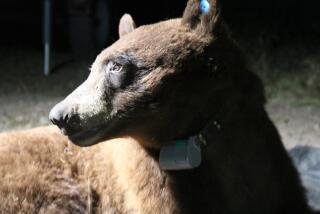Op-Ed: Grizzlies? In California? Why not?
Not long ago, the grizzly bear graced more than the state’s flag in California. In the 1800s, grizzlies could still be spotted swimming to Angel Island, and the man who became known as Grizzly Adams reportedly took his pet grizzly for regular walks in downtown San Francisco.
But by the time it was designated the state animal in 1953, the bear emblazoned on the state flag and seal had been wiped out in California for nearly 30 years, with the last one observed in Sequoia National Park in 1924.
Yet accounts from early explorers offer glimpses of the thousands of grizzlies that once roamed from the crest of the Sierra, across the sweeping valleys to coastal beaches. As occurred across the West, grizzlies were poisoned, trapped and shot into oblivion in the Golden State.
In a move to right this historic wrong, I coauthored and submitted a legal petition this summer calling for the U.S. Fish and Wildlife Service to meet its legal duty under the Endangered Species Act and work to return grizzly bears to a larger portion of their suitable habitat across the West. This includes the Sierra Nevada, where scientists have identified sufficient space for a bear population.
There is no question that some will argue that California has too many people to support grizzly bears or that the bruins are simply too dangerous to bring back. But over the last several decades, we have learned much about how to live with these impressive animals. California has the space for bears and people.
Although more than 3 million people visit Yellowstone National Park every year, incidences of grizzly bear attacks are very low. According to statistics from the National Park Service, the chances of being injured by a bear in Yellowstone are about 1 in 3 million — a substantially lower risk than of being injured in a car accident when traveling in the park.
Living with grizzlies, however, does require people, particularly backcountry visitors, to take precautions, such as carrying bear spray and making noise while hiking. But as demonstrated in Yellowstone and many other areas, it can be done. Indeed, the close cousin of the grizzly bear, the European brown bear, is making a comeback in many areas, including France, Spain, Italy and Switzerland.
Here in the U.S., though, grizzly bears occupy just 4% of their historic range in the lower 48 states, primarily in and around Yellowstone and Glacier National Parks, and number only roughly 1,500 to 1,800 bears there. This small number is simply not enough to ensure the long-term survival of the grizzly in the face of climate change and the ever-growing footprint of human development.
Our petition asks the U.S Fish and Wildlife Service to do something that the agency admits needs to be done: revise the 1993 recovery plan for the grizzly bear and consider additional areas for recovery. The petition does not seek the immediate reintroduction of grizzly bears to California, but rather the careful study and public education necessary to lay the groundwork for bringing these magnificent animals back to the state.
The loss of the grizzly bear in California is not an isolated problem. Rather, large predators, including sharks in the oceans, lions on the African savanna and tigers in India, have been exterminated across huge swaths of the planet, with disastrous consequences for ecosystems.
As apex predators — adult animals that have no natural predators in their ecosystem — grizzly bears play an outsized role in shaping the landscapes in which they live. They shape prey populations like deer and elk and increase plant diversity through digging and seed transport.
The great bears also play an outsized role in our imagination, both feared and revered for their power and grace. It’s time to embrace our legal and moral duty to make sure grizzly bears are around for centuries to come by bringing them home to the Sierra Nevada and elsewhere in the West.
It won’t be easy, but all the facts suggest it can be done.
Noah Greenwald directs the endangered species program at the Center for Biological Diversity.
Follow the Opinion section on Twitter @latimesopinion
More to Read
A cure for the common opinion
Get thought-provoking perspectives with our weekly newsletter.
You may occasionally receive promotional content from the Los Angeles Times.










